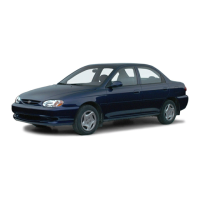
Do you have a question about the Kia SEPHIA 2000 and is the answer not in the manual?
| Brand | Kia |
|---|---|
| Model | SEPHIA 2000 |
| Category | Automobile |
| Language | English |
Explains how to navigate and interpret the owner's manual for optimal usage.
Provides guidance on the initial operating procedures for a new vehicle to ensure proper performance and longevity.
Highlights the key interior and exterior features of the vehicle, including major components.
Details the layout and function of the vehicle's instrument cluster and dashboard controls.
Information about the vehicle's ignition keys, including the key code and its importance.
Explains the operation of manual and optional automatic door locking systems.
Details the function and operation of the optional automatic door locking system and child safety locks.
Covers the operation of manual and power windows, including master controls and lock features.
Provides instructions on adjusting front seats, including fore/aft, recline, and height adjustments.
Explains the proper use, system components, and warnings related to the vehicle's safety belt system.
Details the anchor points and fitting procedures for child restraint systems in the vehicle.
Instructions on how to open, close, and secure the vehicle's trunk lid.
Guidance on opening and closing the vehicle's hood, including latch mechanisms and support.
Information on how to open and close the fuel filler door.
Explains the adjustment of interior and exterior rearview mirrors, including manual and electric controls.
Details the different positions of the ignition switch and their functions, including steering column lock.
Provides step-by-step instructions for starting the vehicle's engine, covering both manual and automatic transmissions.
Explains the gear shifting pattern and operation of the manual transmission.
Details the operation of the automatic transmission, including gear selection and ranges.
Information on the vehicle's brake system, including power brakes and Anti-Lock Brake System (ABS).
Instructions on how to apply and release the parking brake, including its function and related warnings.
Explains the function and checks for the power steering system.
Details the operation of the cruise control system, including setting, canceling, and resuming speed.
Provides an overview of the instrument cluster, including gauges, indicators, and warning lights.
Explains the function and interpretation of various gauges like speedometer, odometer, fuel, and engine temperature.
Lists and explains the various warning lights and audible indicators on the instrument panel.
Specifies the type of fuel required for the vehicle and cautions against incorrect fuel usage.
Information regarding the vehicle's emission control system and modifications.
Guidelines for safe operation and maintenance of the catalytic converter system.
Checklist of essential checks and preparations before operating the vehicle.
Tips and advice for improving fuel economy and reducing operating costs.
Advice for driving in hazardous conditions like rain, snow, or mud.
Details the function and operation of the hazard warning flasher system.
Provides procedures to follow if the vehicle's engine experiences overheating.
Instructions and safety precautions for jump-starting a vehicle with a dead battery.
Explains the vehicle's electrical system protection through fuses and their replacement.
Provides guidelines and precautions for towing the vehicle, including proper procedures and equipment.
Instructions for storing spare tire, jack, and tools, and removing/installing a compact spare tire.
Step-by-step guide for safely changing a vehicle tire, including jacking instructions.
Outlines the importance of scheduled maintenance and owner responsibilities.
Details the recommended maintenance schedule for normal operating conditions.
Outlines the recommended maintenance schedule for severe operating conditions.
Guidance on routine maintenance tasks that owners can perform themselves.
Diagram and labels for key components in the engine compartment.
Instructions for checking and changing the engine oil and oil filter.
Information on checking and maintaining the engine's cooling system and coolant.
Guidance on checking brake fluid level and parking brake operation.
Instructions for checking the power steering fluid level.
Guidance on checking the automatic transaxle fluid level.
Information on checking washer fluid and body lubrication.
Instructions for replacing the air cleaner element.
Covers maintenance and replacement of windshield wiper blades.
Lists the wattage for various exterior and interior light bulbs.
Provides tire size and recommended inflation pressures.
Details engine specifications like displacement, bore, stroke, and compression ratio.
Lists fluid capacities for engine oil, coolant, and fuel tank.